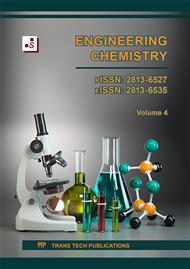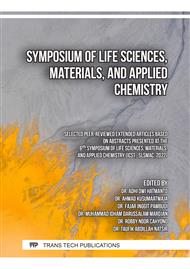[1]
S.H. Chang, An overview of empty fruit bunch from oil palm as feedstock for bio-oil production, Biomass and Bioenergy 62 (2014) 174–181.
DOI: 10.1016/j.biombioe.2014.01.002
Google Scholar
[2]
A.D. French, Glucose, not cellobiose, is the repeating unit of cellulose and why that is important, Cellulose 24 (2017), 4605–4609, 2017.
DOI: 10.1007/s10570-017-1450-3
Google Scholar
[3]
B. Fei, R.A. Wach, H. Mitomo, F. Yoshii, T. Kume, Hydrogel of biodegradable cellulose derivatives. I. Radiation-induced crosslinking of CMC, J. Appl. Polym. Sci. 78 (2000) 278–283.
DOI: 10.1002/1097-4628(20001010)78:2<278::aid-app60>3.0.co;2-9
Google Scholar
[4]
F.N. Mohammad Padzil, S. H. Lee, Z. M. A. ari Ainun, C. H. Lee, L. C. Abdullah, Potential of oil palm empty fruit bunch resources in nanocellulose hydrogel production for versatile applications: A review, Materials 13 (2020).
DOI: 10.3390/ma13051245
Google Scholar
[5]
R. Datta, Acidogenic fermentation of lignocellulose–acid yield and conversion of components, Biotechnol. Bioeng. 23 (1981) 2167–2170.
DOI: 10.1002/bit.260230921
Google Scholar
[6]
L. Segal, J.J. Creely, A.E. Martin, C. M. Conrad, An Empirical Method for Estimating the Degree of Crystallinity of Native Cellulose Using the X-Ray Diffractometer, Text. Res. J. 29 (1959) 786–794.
DOI: 10.1177/004051755902901003
Google Scholar
[7]
H. Kristanoko, F. Kusnandar, D. Herawati, Analisis warna berbasis smartphone android dan aplikasinya dalam pendugaan umur simpan konsentrat apel, agriTECH 41 (2021) 211.
DOI: 10.22146/agritech.52956
Google Scholar
[8]
T. H. Kim, Pretreatment of Lignocellulosic Biomass, Bioprocess. Technol. Biorefinery Sustain. Prod. Fuels, Chem. Polym. (2013) 91–110.
Google Scholar
[9]
O. Sevastyanova, J. Li, G. Geilerstedt, On the reaction mechanism of the thermal yellowing of bleached chemical pulps, Nord. Pulp Pap. Res. J 21 (2006), 188–192.
DOI: 10.3183/npprj-2006-21-02-p188-192
Google Scholar
[10]
A. Castellan S. Grelier, Color reversion of cellulosic and lignocellulosic fibers, Lignocellul. Fibers Wood Handb. Renew. Mater. Today's Environ. (2016) 531–551.
DOI: 10.1002/9781118773727.ch21
Google Scholar
[11]
G. Gellerstedt, M. Pettersson, E. L. Lindfors, D. Robert, Reactions of lignin in chlorine dioxide bleaching of kraft pulps, Res. Chem. Intermed. 21 (1995) 441–456.
DOI: 10.1007/bf03052269
Google Scholar
[12]
W. Farhat, R. A. Venditti, M. Hubbe, M. Taha, F. Becquart, and A. Ayoub, A review of water-resistant hemicellulose-based materials: processing and applications, ChemSusChem. 10 (2017), 305–323.
DOI: 10.1002/cssc.201601047
Google Scholar
[13]
C. Chio, M. Sain, and W. Qin, Lignin utilization: A review of lignin depolymerization from various aspects, Renew. Sustain. Energy Rev. 107 (2019), 232–249.
DOI: 10.1016/j.rser.2019.03.008
Google Scholar
[14]
S. K. Evans, O. N. Wesley, O. Nathan, and M. J. Moloto, Chemically purified cellulose and its nanocrystals from sugarcane baggase: isolation and characterization, Heliyon 10 (2019), p. e02635.
DOI: 10.1016/j.heliyon.2019.e02635
Google Scholar
[15]
C. J. Knill and J. F. Kennedy, Degradation of cellulose under alkaline conditions, Carbohydr. Polym. 51 (2002) 281–300.
Google Scholar
[16]
S. Karagöz, T. Bhaskar, A. Muto, and Y. Sakata, Hydrothermal upgrading of biomass: Effect of K2CO3 concentration and biomass/water ratio on products distribution, Bioresour. Technol. 97 (2006) 90–98.
DOI: 10.1016/j.biortech.2005.02.051
Google Scholar
[17]
S. Nam, A. D. French, B. D. Condon, and M. Concha, Segal crystallinity index revisited by the simulation of X-ray diffraction patterns of cotton cellulose Iβ and cellulose II, Carbohydr. Polym. 135 (2016) 1–9.
DOI: 10.1016/j.carbpol.2015.08.035
Google Scholar
[18]
P. Langan, Y. Nishiyama, and H. Chanzy, X-ray structure of mercerized cellulose II at 1 Å resolution, Biomacromolecules 2 (2001) 410–416.
DOI: 10.1021/bm005612q
Google Scholar



